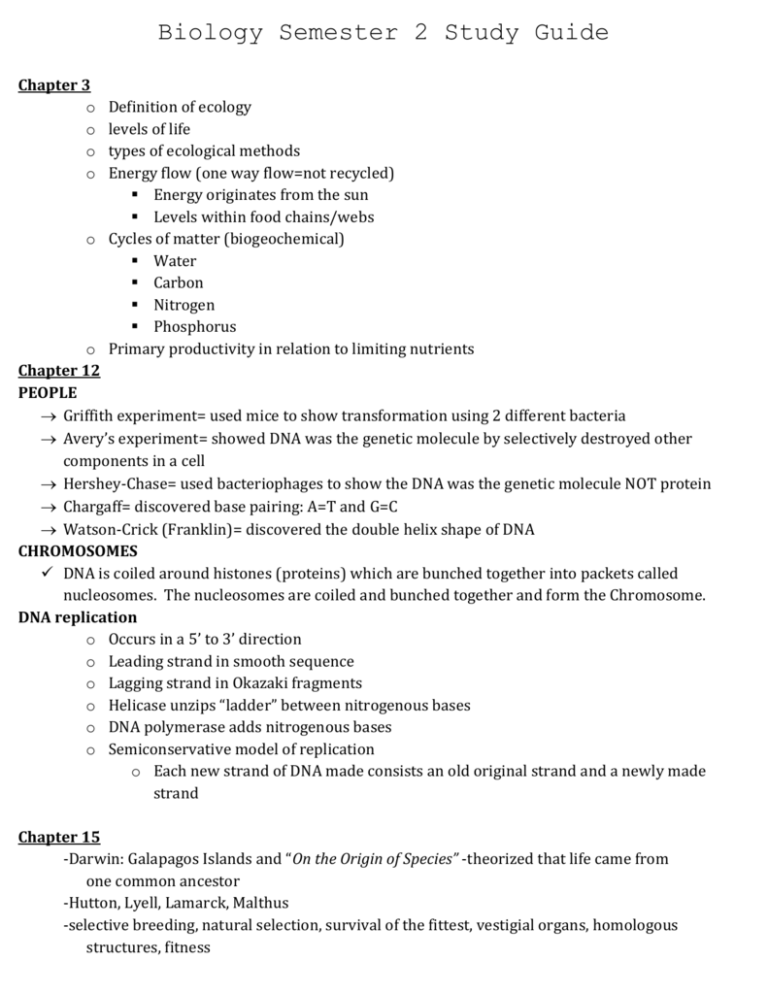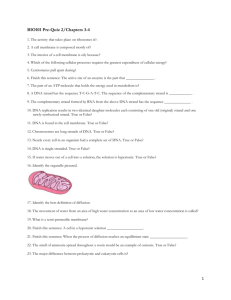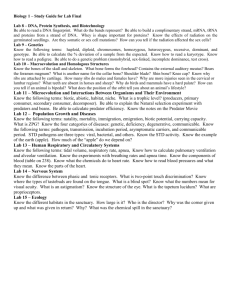Biology Semester 2 2014
advertisement

Biology Semester 2 Study Guide Chapter 3 o o o o Definition of ecology levels of life types of ecological methods Energy flow (one way flow=not recycled) Energy originates from the sun Levels within food chains/webs o Cycles of matter (biogeochemical) Water Carbon Nitrogen Phosphorus o Primary productivity in relation to limiting nutrients Chapter 12 PEOPLE Griffith experiment= used mice to show transformation using 2 different bacteria Avery’s experiment= showed DNA was the genetic molecule by selectively destroyed other components in a cell Hershey-Chase= used bacteriophages to show the DNA was the genetic molecule NOT protein Chargaff= discovered base pairing: A=T and G=C Watson-Crick (Franklin)= discovered the double helix shape of DNA CHROMOSOMES DNA is coiled around histones (proteins) which are bunched together into packets called nucleosomes. The nucleosomes are coiled and bunched together and form the Chromosome. DNA replication o Occurs in a 5’ to 3’ direction o Leading strand in smooth sequence o Lagging strand in Okazaki fragments o Helicase unzips “ladder” between nitrogenous bases o DNA polymerase adds nitrogenous bases o Semiconservative model of replication o Each new strand of DNA made consists an old original strand and a newly made strand Chapter 15 -Darwin: Galapagos Islands and “On the Origin of Species” -theorized that life came from one common ancestor -Hutton, Lyell, Lamarck, Malthus -selective breeding, natural selection, survival of the fittest, vestigial organs, homologous structures, fitness -common genes= common ancestor Chapter 16 Mutations and gene shuffling create variation Gene pool in relation to allele frequencies 3 types of natural selection on polygenic traits (disruptive, directional, and stabilizing) Genetic Drift 1. Founder effect and Bottleneck effect HW and 5 conditions that must be met 1. Random mating 2. Large Population 3. No Movement into or out of Population 4. No Mutations 5. No Natural Selection Speciation 1. Behavioral Isolation 2. Geographic isolation 3. Temporal isolation Chapter 17 -Fossils *Formation *Examples *Types *Location relative to age -Geologic Time Scale Divisions -Earth *Many stages and changes Atmosphere Organisms -Evolutions -Endosymbiotic Theory Chapter 18 -Binomial nomenclature -classification order DKPCOFGS -cladogram, derived characters, evolutionary classification -Characteristics of Domains (Peptidoglycan) Chapter 19- Bacteria and Viruses Characteristics Shapes Reproductive Cycles Structures Gram Staining Ecology roles Illness o Treatment, prevention, and causes Chapter 21- Fungus Feeding Structure Reproduction (general) Lifecycle Types/Phyla Ecological Role Symbiotic Relationships Chapter 22- Plants Characteristics How do they make food Evolution o Types o Traits Importance of water Reproduction Life Cycle Terms











